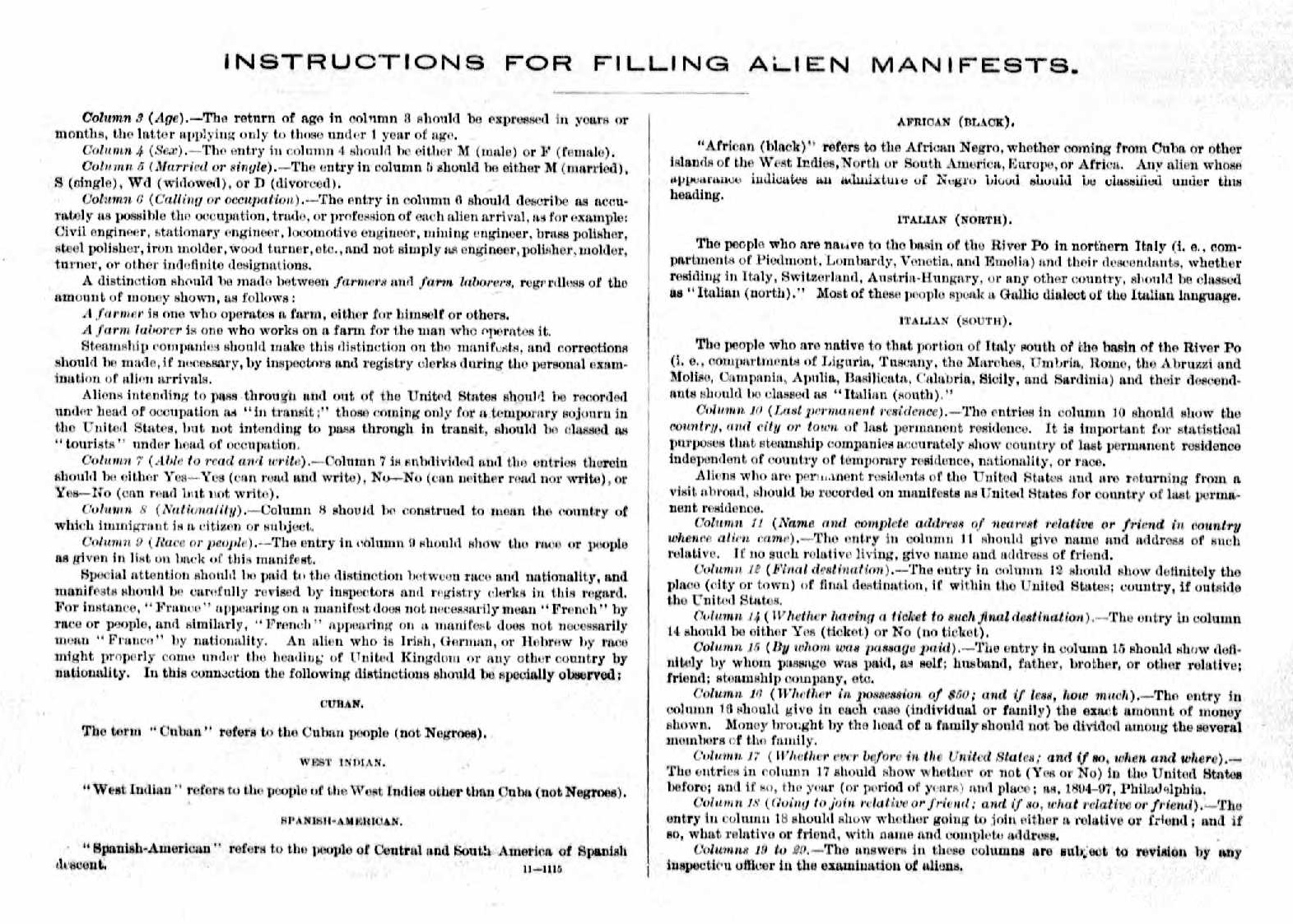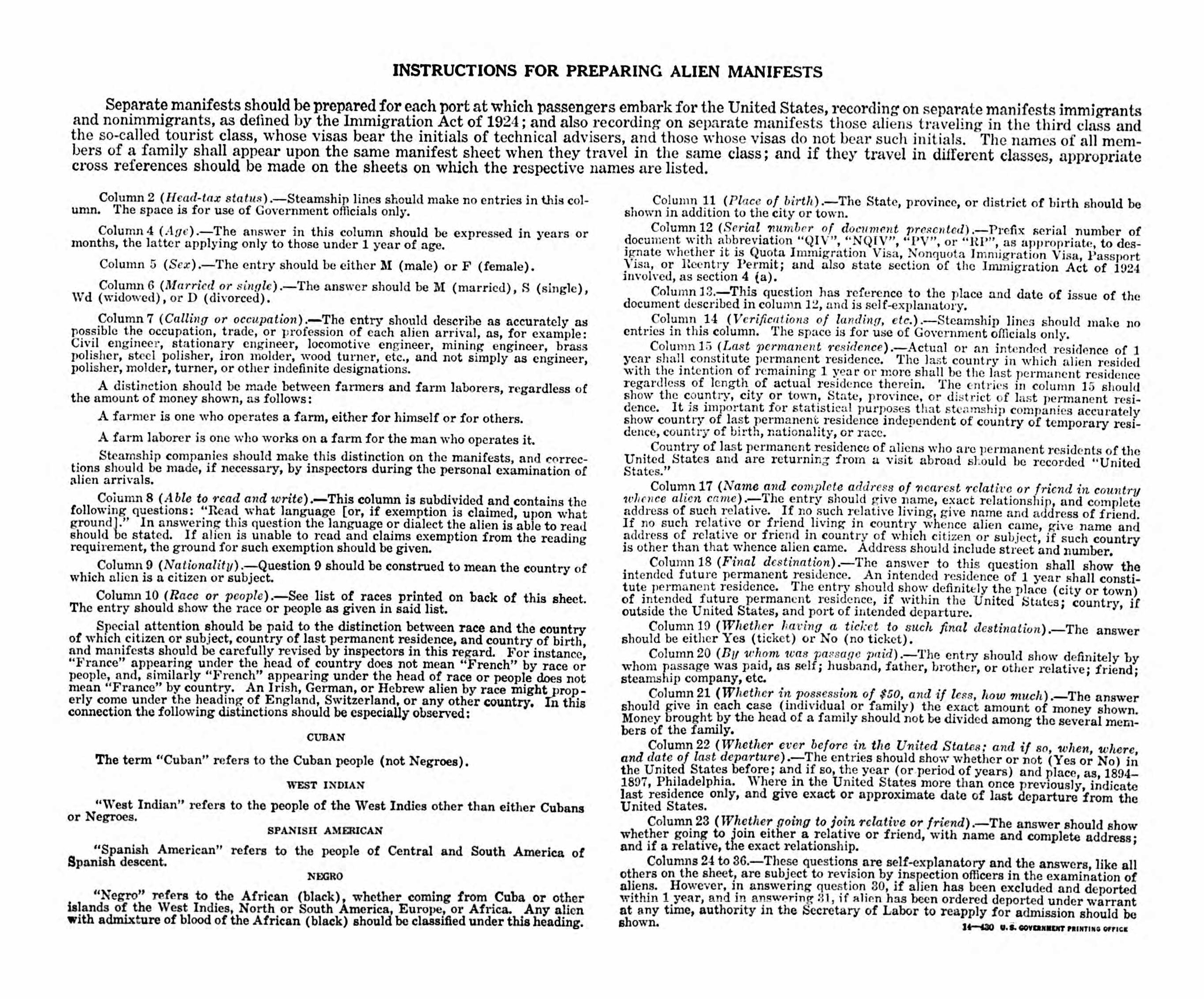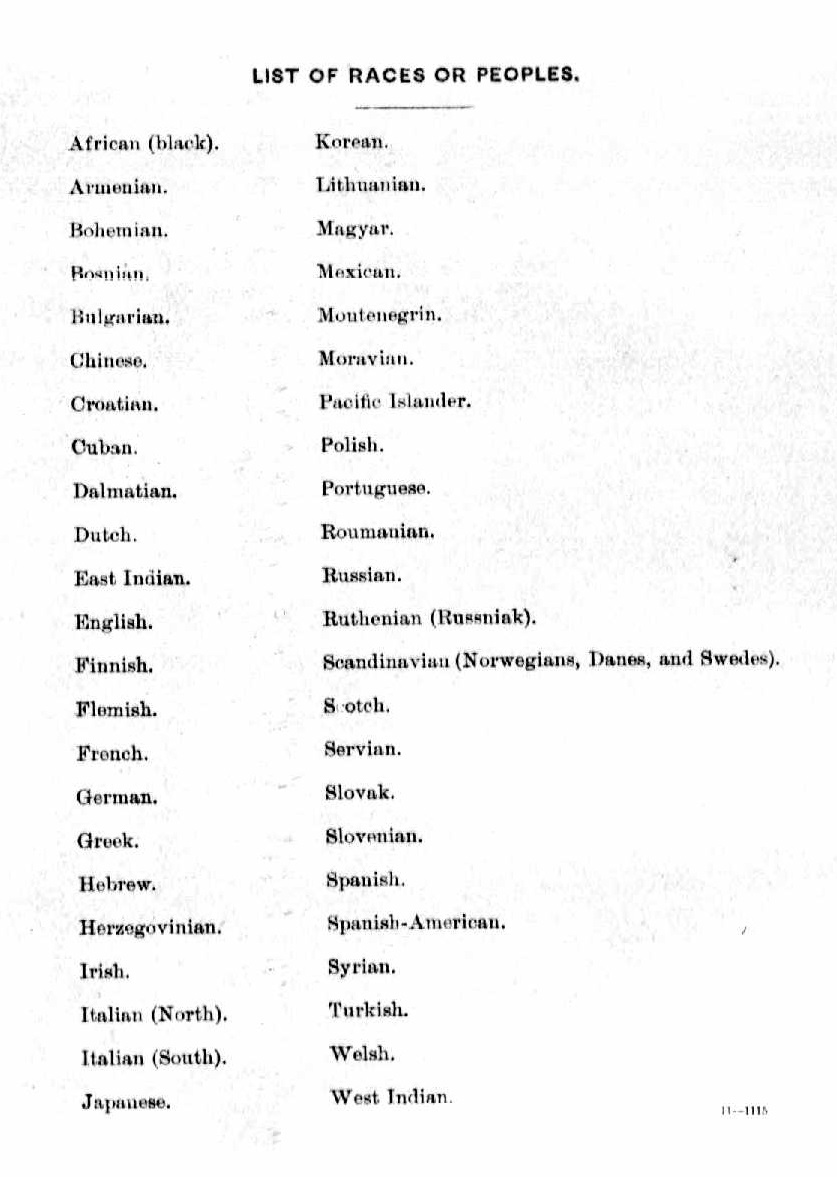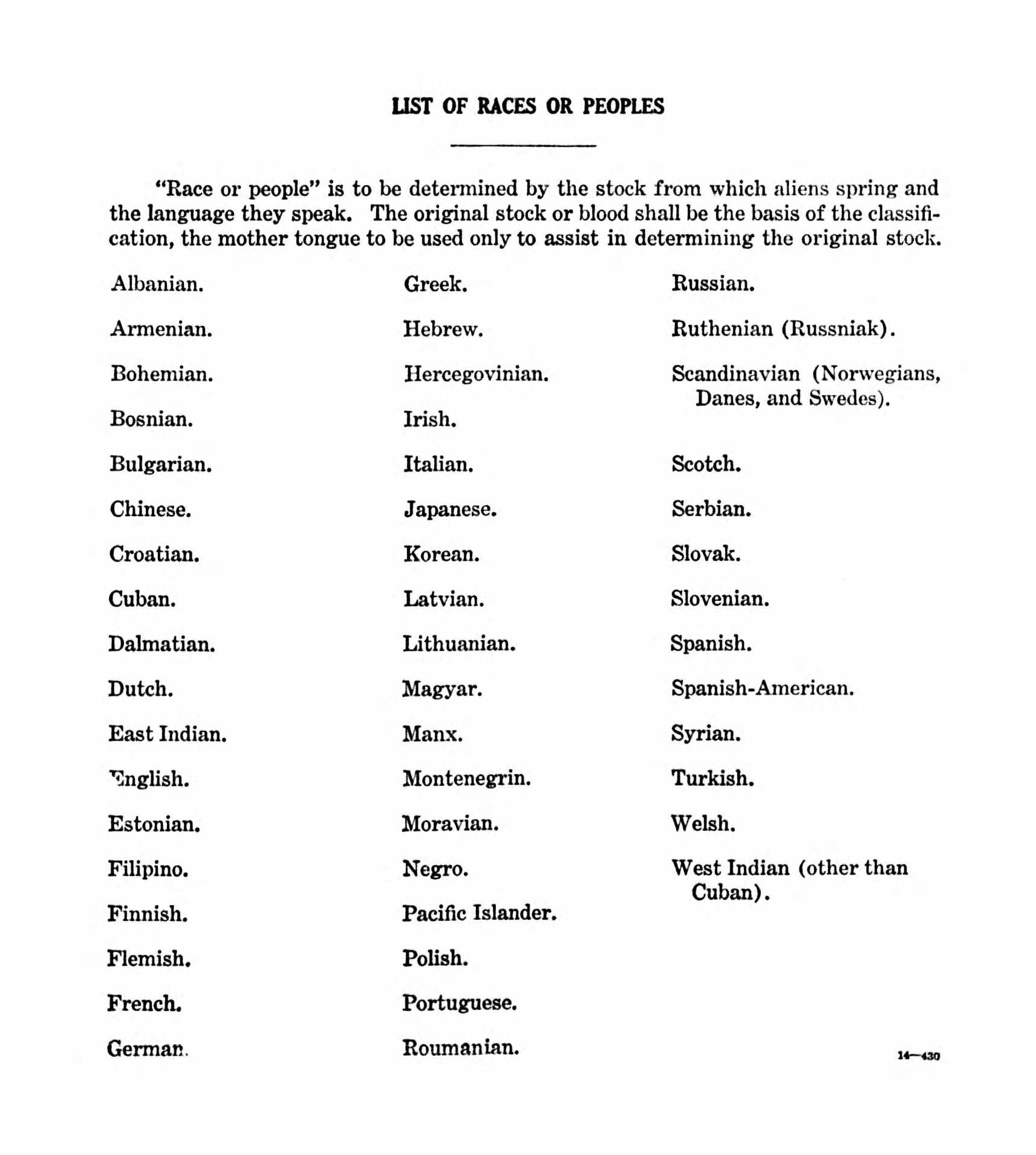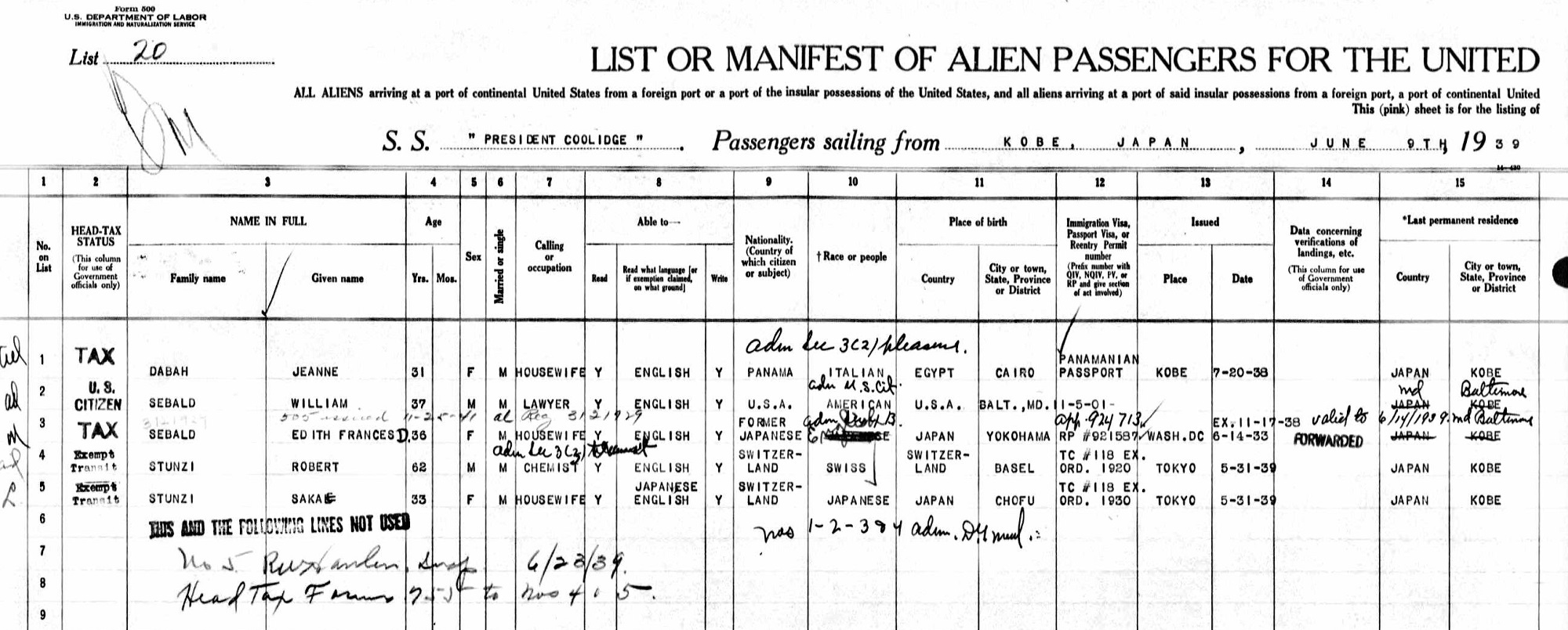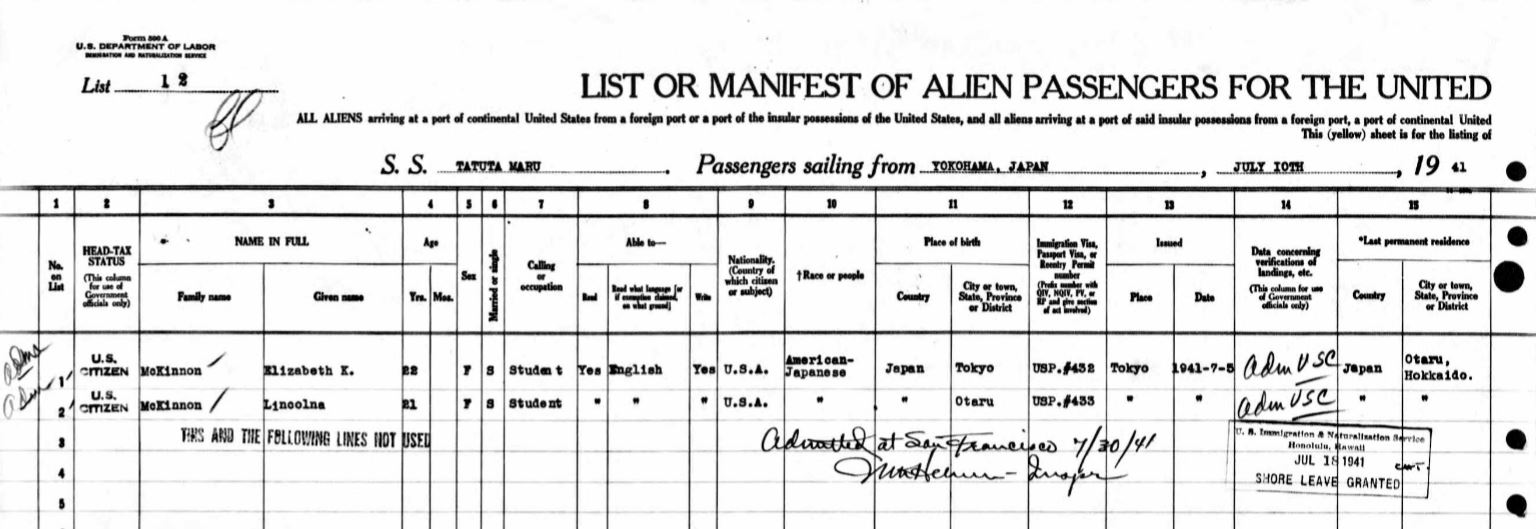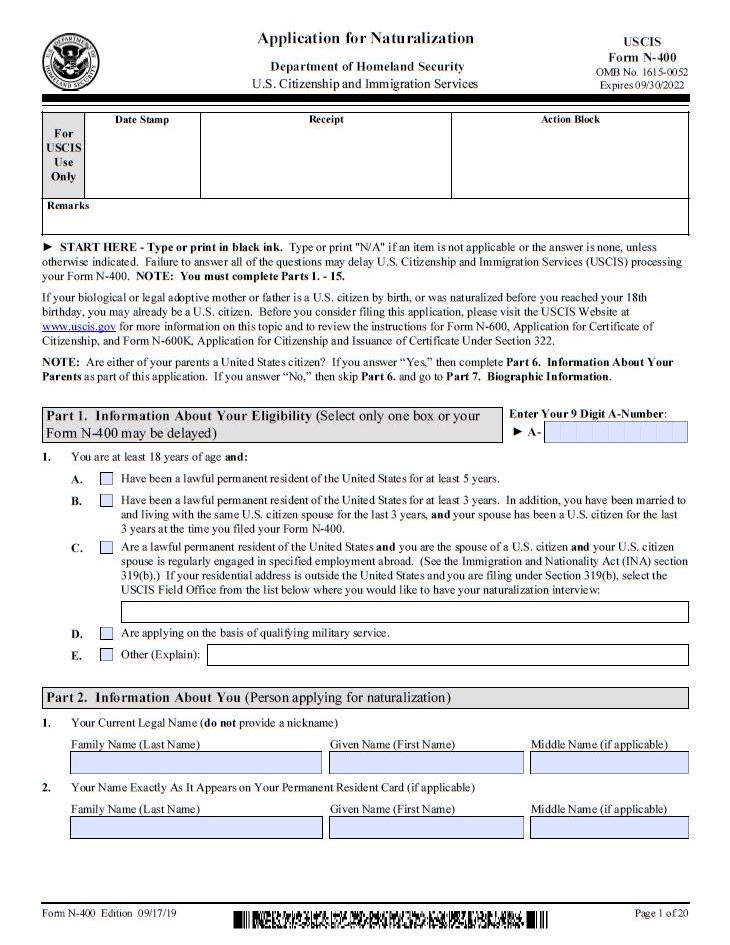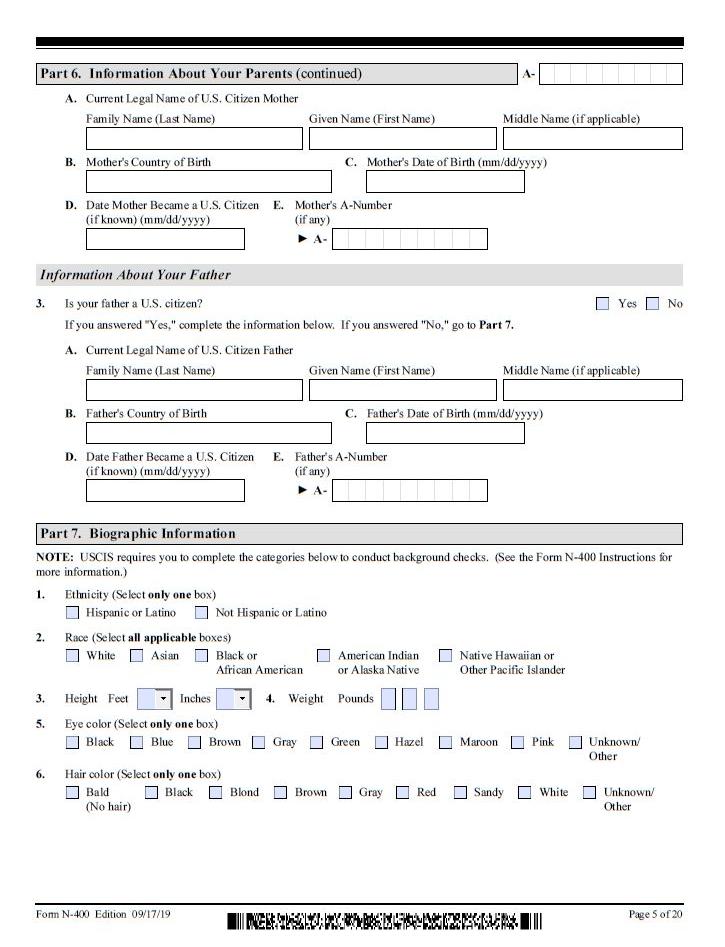Race boxes at ports of entry
How passenger manifests racialized aliens arriving in the US (and Canada)
By William Wetherall
Drafted 9 September 2009
First posted 1 December 2009
Last updated 26 July 2022
Immigration control
Passports and other certifications of affiliation, status, and authorization at ports of entry
1911 Race or People guidebook (United States)
Aino
•
Japanese
•
Korean
Alien passenger manifest guidelines
United States
•
Canada
Naturalization
Race boxes on U.S. naturalization application forms
Immigration control
The United States required racial classifications on passenger manifests, and in 1911 the Government Printing Office in Washington, D.C. published Dictionary of Races or Peoples. Compiled by the Immigration Commission for the purpose of facilitating such classifications, the guide was written not for the "ethnologist" but for the "student of immigration" who wants "an approximately correct statement as to the ethnical status of immigrant races or peoples, their languages, numbers, and the countries from which they come" (Introductory, page 3).
The introduction speaks of the "five grand divisions" -- "the Caucasian, Ethiopian, Mongolian, Malay, and American, or, as familiarly called, the white, black, yellow, brown, and red races" -- "made upon physical or somatological grounds, while the subdivisions of these into a multitude of smaller 'races' is made largely on a linguistic basis" (Introductory, page 3).
1911 Race or People Guidebook (United States)
INS officials in the United States used the Dictionary of Races or Peoples, prepared in 1911, until the early 1950s.
The following transcription of the cover of the first edition of the guidebook is based on scans at The Internet Archive. A copy is also posted at UM Digital Library Production Service (UMDL) [University of Michigan].
|
61st Congress |
SENATE |
Document |
|
REPORTS OF THE IMMIGRATION COMMISSION DICTIONARY OF RACES OR Presented by Mr. DILLINGHAM WASHINGTON |
||
The 1911 guidebook had hundreds of classifications, including the following, in alphabetical order. I have shown the page number of the start of entry in [brackets].
|
AFRICAN (black). (See Negro.) [page 13] AINO. [page 13] CAUCASIAN, CAUCASIC, EUROPEAN, EURAFRICAN, or WHITE race. [page 30]. FILIPINO or PHILIPPINE ISLANDER. [page 51]. HAWAIIAN or SANDWICH ISLANDER. [page 73] HEBREW, JEWISH, or ISRAELITE. [page 73] INDIAN, AMERINDIAN, AMERICAN, or RED race. [page 77] JAPANESE. [page 85] The people of the Korean peninsula. |
Aino
The full AINO entry in the 1911 edition of Dictionary of Races or Peoples is as follows (page 13, left).
|
AINO. A primitive Caucasian-like People in Japan, now numbering less than 20,000. (See Japanese, Cau- casian, and Mongolian.) |
Japanese
The full JAPANESE entry in the 1911 edition of Dictionary of Races or Peoples is as follows (pages 85-86).
|
JAPANESE. The people of Japan. Although many people may mistake The social characteristics and impor- |
Korean
The full KOREAN entry in the 1911 edition of Dictionary of Races or Peoples is as follows (pages 87-88).
|
KOREAN. The people of the Korean |
Alien passenger manifest guidelinesThe "Instructions for Filling (Preparing) Asian Manifest" and the associated "List of Races or Peoples" show how manifests were handled in 1908 and 1941. There are no remarkable in the purpose of the manifests and the manner in which they were to be completed by a ship's officer for the purpose of filing with an immigration official at a port of entry into the United States (or Canada). The officer in charge of completing the manifest did so in various ways. Some manifests were typed, others hand written. Some showed names in alphabetical order, others not. I have no idea how officers typically completed the forms -- whether in their office from collected travel documents, or by calling passengers to their office or making rounds of cabins and berths. Some hand-written information is clearly the work of an immigration official. Other hand-written corrections or modifications could the work of either a ship's officer or an immigration official in the course of vetting the information directly with the passenger. The "Nationality" box was completed with the name of the country of which the passenger was a subject, national, or citizen, as shown by a passport or equivalent travel document. Ordinarily, this would be country that issued the passport. Accordingly, the "Nationality" box would not be subject to negotiation because it was totally objective. Only the authenticity of a passenger's documents might cause the information in the box to be disputed. The "Race or people" box could be negotiated if either the passenger or the ship's officer or immigration official differed in their view point. The more manifests you see, the more variation you will encounter in the way this box was completed -- especially in cases of passengers whose personal identities were listed, or whose identities fell between the prescribed choices. "Japanese" is listed but "American" is neither listed nor self-evident. I have never seen "American" used to qualify the "Race or people" of a non-U.S. national, so it must imply some sort of racioethnic quality, on a par with "Japanese" or "Hebrew" or "Slovak". My impression is that "American" is most commonly used to qualify the racioethnicity a mongrel Cacasoid U.S. citizen who does not admit to being "German" or "French" or "Swiss" or "Chinese" in some ancestral sense. Hence "American" combined with a listed "Race or people" would signify someone of mixed blood. 23 June 1939 -- Edith SewaldA passenger manifest shows William Sebald and his wife Edith arriving at San Francisco from Kobe on 23 June 1939. Edith has lost Japan's nationality on account of marrying an American man, but she has failed to acquire America's nationality through the marriage because her Japanese blood makes her ineligible for citizenship. The manifest shows Edith's nationality as "Former Japanese" -- rather than "Formerly Japan" or "Stateless", which would better conform to the conventions of the "Nationality" box. But whereas her husband is an "American" by "Race or people", she is " Notice the Swiss couple below the Sebalds. The wife is "Switzerland" by "Nationality" and "Japanese" by "Race or people". She has acquired Swiss nationality through her marriage, under the same sort of operation of Japan's and Switzerland's laws that would have resulted in Edith possessing "U.S.A" like her husband if America's laws had not been racist. Edith would acquire U.S. citizenship in 1947 through the passage in Congress of a private bill that relieved her of the racial restrictions that still operated in America's Naturalization Act at the time. For details, see Fully stateless Edith Sebald (1902-1981) in the "Statelessness in Japan" article in the "Nationality" section of the Yosha Bunko website. 10 July 1941 -- McKinnon sistersA "List or Manifest of Alien Passengers for the United States Immigration Officer at Port of Arrival" shows Elizabeth K. [Kimiko] McKinnon (1918-2013), and her sister Lincolna McKinnon [Guilfoile] (1920-2017), arriving in San Francisco on 30 July 1941, aboard the S.S. Tatuta Maru, which had sailed from Yokohama on 10 July 1941. The sisters are "U.S.A." by "Nationality (County of which citizen or subject)" but "American-Japanese" by "Race or people". Elizabeth McKinnon was assisting Serge Elisséeff and Edwin O. Reischauer in their Japanese-language teaching at Harvard before the Pacific War. She then became an instructor at the U.S. Navy's Japanese Language School (JLS) at the University of Colorado. JLS was set up in Japan after the Russo-Japanese War (1904-1905), and William Sebald had studied there in the 1920s. The school left Japan in the late 1930s as US-Japan relations worsened and was at the University of California at Berkeley when the war began. However, it was moved to the University of Colorado in order to be outside the westcoast military zone within which most people of "Japanese ancestry" were not allowed to reside -- so that its faculty, consisting mainly of alien and American faculty members of Japanese descent, could continue teaching what had become the enemy's language. Elizabeth McKinnon later married the linguist Denzil Carr (1900-1983), who had been a Japanese language specialist in the 1930s before shifting to Malay-Polynesian. Denzil Carr became a professor of linguistics at UCB, and in the late 1960s, when I was a student in the Oriental Language Department, I would know Elizabeth McKinnon as Elizabeth Carr, or Professor Carr, my first classical Japanese teacher. For details about the McKinnon-Mishima family in Japan and America, see McKinnon-Mishima on the "Couples 2" page under "Couples" in the "People" section of the Konketsuji website. For a look at Elizabeth Kimiko (McKinnon) Carr's life, see Elizabeth Carr: Japanese Language School instructor on the "Keene, Seidensticker et al." page under "Translations" on the Yosha Bunko website. |
United States
The United States set the example for the fairly small number of countries that sought to racialize people at their ports of entry. Other countries that did so generally adopted the classification rules used by the United States, but with some variations.
Sources of information
The following overview of the history of the overseeing of immigration in the United States is based on various guides related to Records of the Immigration and Naturalization Service (INS) section [/research/guide-fed-records/groups/085.html] of The National Archives, a US government website managed by the National Archives and Records Administration (NARA).
The transcriptions of the text on alien passenger manifests and instructions related to nationality and race were partly based on information obtained from various genealogy websites which have posted transcriptions of selected manifests for their users -- and partly based on images of actual passenger manifest documents posted in the Immigration Records (Ship Passenger Arrival Records) section [/genealogy/immigration/] of the website of The National Achieves website.
Availability of alien passenger manifests
The Freedom of Information Act of 1966 makes most federal records related to immigration and naturalization available to the public, subject to restrictions by the the Privacy Act of 1974. In principle, passenger manifests are accessible, and NARA now facilitates individuals seeking to confirm records of arrival of immigrant ancestors on America's shores.
The general public interest in early passenger manifests at ports of entry to the United States is thus mostly genealogical. My interest in the manifests, though, concerns how arriving aliens were described by nationality and race.
Overseeing immigration
Naturalization and immigration matters were handled by various departments of the US government since 1797. Such matters were usually overseen by a single department, which acted as the competent agency, meaning the agency with was primarily responsible for implementing and enforcing related laws. However, other departments were delegated administrative tasks to facilitate implementation and enforcement.
Aliens applying for visas and other permits at US consulates get the impression that the Department of State controls immigration. At one time it was the competent department, but for more than a century it has acted only as an overseas agent for other departments.
Such division of labor is common in other countries, including Japan. Japanese consulates, under the Ministry of Foreign Affairs, process applications for visas and other permits to enter Japan. But relevant laws and regulations -- meaning the processing and issuance rules -- are under the Ministry of Justice. And the visas issued by consulates are provisional -- i.e., meaningless -- until they are recognized and approved at a port of entry in Japan by an immigration officer, who reviews the alien's qualifications for the provisional permit, and has the authority to refuse admission to Japan, or to change the type of visa or other permit and attached conditions.
Department of State
Secretary of State (1819-1864)
Commissioner of Immigration (1864-1868)
Secretary of State (1868-1874)
Department of the Treasury
Secretary of the Treasury (1869-1891)
Office of the Superintendent of Immigration (1891-1895)
Bureau of Immigration (1895-1903)
Department of Commerce and Labor
Bureau of Immigration (1903-1906)
Bureau of Immigration and Naturalization (1906-1913)
Department of Labor
Bureau of Immigration (1913-1933)
Bureau of Naturalization (1913-1933)
To be continued.
Canada
Canada to some extent followed the United States passenger manifest rules -- at least at ports like Victoria, which facilitated entry to the United States.
To be continued.
Race boxes on American naturalization formsNaturalization in the United States has a history of predicating qualifications for naturalization on race. From the late 19th century through the middle of the 20th century, foreign men and women whose "national origin" was China, Japan, and Korea, but also India and other countries regarded as "Oriental" -- were generally regarded as "ineligible to naturalization". And foreign women who stood to derive U.S. citizenship through marriage to an American man were "ineligible to citizenship" if they were 50 percent or more of "Oriental" blood. Today, there are no racial bars to naturalization, and citizenship is no longer derivable through marriage. But some conditions permanently bar an applicant from naturalization, and other may temporarily impair naturalization. Grounds for permanent barring eligibility for naturalization included a conviction of murder or certain other aggravated felonies, involvement in or aiding or abetting Nazi activities, genocidal or extrajudicial killings, torturing, and other such acts. An applicant may also be barred if, within the past five years, one as practiced polygamy, failed to pay child support, been an alcoholic, trafficked drugs, been involved in prostitution, or failed to register for selective service, among other such acts. Regarding military service, past refusal to serve as an alien, or desertion while serving as an alien, are likely to be permanent bars. Still -- though race is not longer supposed to affect naturalization, application forms continue to solicit both "ethnicity" and "race", as shown on the images to the right, from Form N-400 as of 2019-2022. Application for Naturalization |
||||
